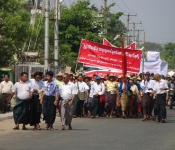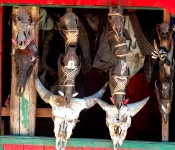Pyay (Prome), here are some impressions of these wonderful little city beside the Ayeyarwady river.
Introducing Pyay (Prome),
a breezy location on the Ayeyarwady River.
Pyay was formerly known as Prome. Pyay is an important commercial center for trade between the Ayeyarwady Delta. Central and Upper Myanmar and the Rakhine (Arakan) State. Pyay is only 161 km north of Yangon travelling along a well-maintained highway by car. You can see green paddy fields along the side of the highway. Several trains run daily from Yangon on the first railway line built in Myanmar in 1877. In the last few years the railway branch lines have been extended north towards Bagan. It is a city halfway between Yangon and Bagan. Visitors can stop over in Pyay and travel on to Bagan and Mandalay. Pyay is situated on the eastern bank of the Ayeyarwady River on a lovely location.
Pyay was anglicized as Prome after the Second Anglo-Myanmar war and in ancient times was known as Thaye-khittra (Srikshetra). Srikshetra. the ancient Pyu capital about five miles to the east. is interesting place to visit because of their historical importance and archaeological sites.
Interesting Places
Interesting Places in Pyay are Shwesandaw Pagoda. Sehtetgyi Pagoda (the gigantic sitting Buddha image). Baw Baw Gyi Pagoda. Be Be Gyi Pagoda and Payama Pagoda. Other interesting places around pyay are Ahkauktaung. Shwe Myatman Paya. Shwe Nat Taung Pagoda and Shwe Bonthar Muni.
SRIKSHETRA ANCIENT DAYS
An ancient ‚Pyu‘ Capital lies 8 km south-east of Pyay ( Prome). is located about 285 km north-west of Yangon. Archaeological discoveries indicate that the city attained its height of prosperity between the 5th and 9th centuries. In Tha-ye-khit-taya. one will find palace site the prototype of Bagan vaulted temple such as Lemyethna and East Zegu. the cylinder-shaped Bawbawgyi Pagoda. Payagyi and Payama stupas each with a high conical dome and the Archaeological Museum.
SHWESANDAW PAGODA
The Shwesandaw Pagoda is well known in Pyay. Shwesandaw meaning the Golden Hair Relics. The Pagoda is situated on the eastern bank of Ayeyarwaddy river and Myanmar’s most venerated structure stands here. The former name of the pagoda was known to be Mya Thi Htin. It has a height of 127 feet high and standing on the plinth making a total measurement of 290 feet from the base. There are 64 surrounding smaller pagodas around the main one. There is a chamber in the southern sector of the platform housing a duplicate of the Buddha’s tooth relic of Kandy. Having been placed beside the original tooth-relic of Kandy for a time it is believed to have absorbed the aura of the original and become just as potent. The tooth-relic from the Shwesandaw Pagoda is customarily taken out from its chamber in the month of Dazaungmone (November-December) every year and ceremoniously taken on a tour of the city once every three years so that worshippers might pay homage to it and revere it with their own eyes.
SEHTATGYI PAYA
Looking east from the stupa you’ll see an enormous seated Bhudda figure rising up from the treeline. From the Shwesandaw terrace you look across to the image eye-to-eye. Sehtatgyi meaning ‘Big Ten-storey’ for its height.
MUSEUM
About a kilometer and a half from the highway turnoff by the old palace side. stands a small museum and a map of the area. Inside the museum is a colletion of artifacts collected from Srikshetra exacavations.
BAWBAWGYI PAYA AND BEBE PAYA
South of the museum. outside the city walls. are cylindrical Bawbawgyi Paya and cube-shaped Bebe Paya. Standing over 45 meters high. the brick and plaster of Bawbawgyi Paya is the oldest stupa in the area. Other cube-shaped pagodas in the area include one thought to have been used by a hermit. featuring eight Buddha reliefs along the lower half of the interior wall and a vaulted ceiling of brick. Accessible by car. Only about 6 hours drive from Yangon. There are also express buses carrying passengers everyday.
Post Footer automatically generated by Add Post Footer Plugin for wordpress.























